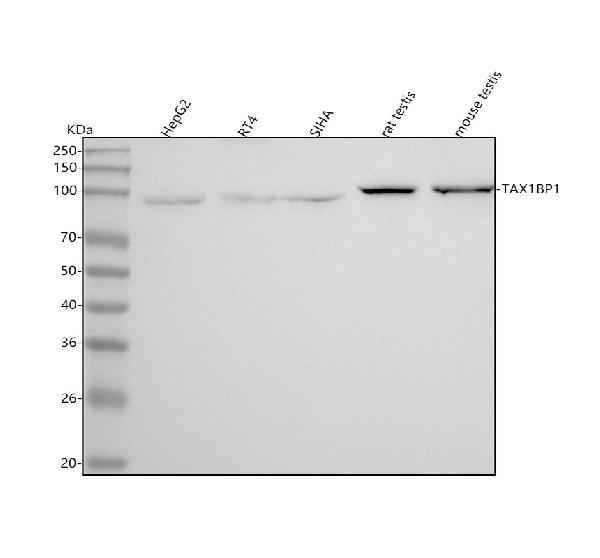Anti-TRAF6BP Rabbit Monoclonal Antibody
- SPECIFICATION
- CITATIONS
- PROTOCOLS
- BACKGROUND

Application
| WB, IF, ICC |
|---|---|
| Primary Accession | Q86VP1 |
| Host | Rabbit |
| Isotype | IgG |
| Reactivity | Rat, Human, Mouse |
| Clonality | Monoclonal |
| Format | Liquid |
| Description | Anti-TRAF6BP Rabbit Monoclonal Antibody . Tested in WB, ICC/IF applications. This antibody reacts with Human, Mouse, Rat. |
| Gene ID | 8887 |
|---|---|
| Other Names | Tax1-binding protein 1, TRAF6-binding protein, TAX1BP1, T6BP |
| Calculated MW | 91 kDa |
| Application Details | WB 1:500-1:2000 ICC/IF 1:50-1:200 |
| Contents | Rabbit IgG in phosphate buffered saline, pH 7.4, 150mM NaCl, 0.02% sodium azide and 50% glycerol, 0.4-0.5mg/ml BSA. |
| Clone Names | Clone: 23T27 |
| Immunogen | A synthesized peptide derived from human TRAF6BP |
| Purification | Affinity-chromatography |
| Storage | Store at -20°C for one year. For short term storage and frequent use, store at 4°C for up to one month. Avoid repeated freeze-thaw cycles. |
| Name | TAX1BP1 |
|---|---|
| Synonyms | T6BP |
| Function | Ubiquitin-binding adapter that participates in inflammatory, antiviral and innate immune processes as well as selective autophagy regulation (PubMed:29940186, PubMed:30459273, PubMed:30909570). Plays a key role in the negative regulation of NF-kappa-B and IRF3 signalings by acting as an adapter for the ubiquitin-editing enzyme A20/TNFAIP3 to bind and inactivate its substrates (PubMed:17703191). Disrupts the interactions between the E3 ubiquitin ligase TRAF3 and TBK1/IKBKE to attenuate 'Lys63'-linked polyubiquitination of TBK1 and thereby IFN- beta production (PubMed:21885437). Also recruits A20/TNFAIP3 to ubiquitinated signaling proteins TRAF6 and RIPK1, leading to their deubiquitination and disruption of IL-1 and TNF-induced NF-kappa-B signaling pathways (PubMed:17703191). Inhibits virus-induced apoptosis by inducing the 'Lys-48'-linked polyubiquitination and degradation of MAVS via recruitment of the E3 ligase ITCH, thereby attenuating MAVS- mediated apoptosis signaling (PubMed:27736772). As a macroautophagy/autophagy receptor, facilitates the xenophagic clearance of pathogenic bacteria such as Salmonella typhimurium and Mycobacterium tuberculosis (PubMed:26451915). Upon NBR1 recruitment to the SQSTM1- ubiquitin condensates, acts as the major recruiter of RB1CC1 to these ubiquitin condensates to promote their autophagic degradation (PubMed:33226137, PubMed:34471133). Mediates the autophagic degradation of other substrates including TICAM1 (PubMed:28898289). |
| Cellular Location | Cytoplasm. Mitochondrion. Preautophagosomal structure Cytoplasmic vesicle, autophagosome |
| Tissue Location | Expressed in all tissues tested. |

Thousands of laboratories across the world have published research that depended on the performance of antibodies from Abcepta to advance their research. Check out links to articles that cite our products in major peer-reviewed journals, organized by research category.
info@abcepta.com, and receive a free "I Love Antibodies" mug.
Provided below are standard protocols that you may find useful for product applications.
If you have used an Abcepta product and would like to share how it has performed, please click on the "Submit Review" button and provide the requested information. Our staff will examine and post your review and contact you if needed.
If you have any additional inquiries please email technical services at tech@abcepta.com.













 Foundational characteristics of cancer include proliferation, angiogenesis, migration, evasion of apoptosis, and cellular immortality. Find key markers for these cellular processes and antibodies to detect them.
Foundational characteristics of cancer include proliferation, angiogenesis, migration, evasion of apoptosis, and cellular immortality. Find key markers for these cellular processes and antibodies to detect them. The SUMOplot™ Analysis Program predicts and scores sumoylation sites in your protein. SUMOylation is a post-translational modification involved in various cellular processes, such as nuclear-cytosolic transport, transcriptional regulation, apoptosis, protein stability, response to stress, and progression through the cell cycle.
The SUMOplot™ Analysis Program predicts and scores sumoylation sites in your protein. SUMOylation is a post-translational modification involved in various cellular processes, such as nuclear-cytosolic transport, transcriptional regulation, apoptosis, protein stability, response to stress, and progression through the cell cycle. The Autophagy Receptor Motif Plotter predicts and scores autophagy receptor binding sites in your protein. Identifying proteins connected to this pathway is critical to understanding the role of autophagy in physiological as well as pathological processes such as development, differentiation, neurodegenerative diseases, stress, infection, and cancer.
The Autophagy Receptor Motif Plotter predicts and scores autophagy receptor binding sites in your protein. Identifying proteins connected to this pathway is critical to understanding the role of autophagy in physiological as well as pathological processes such as development, differentiation, neurodegenerative diseases, stress, infection, and cancer.


